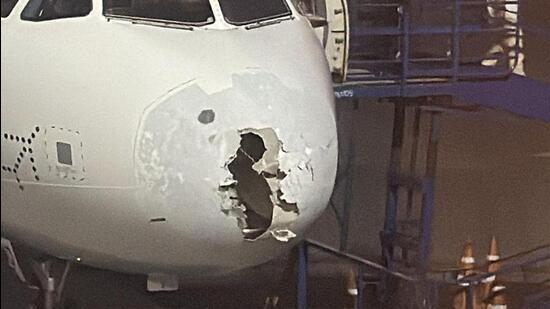
Pak denied IndiGo pilot’s bid to use airspace amid turbulence which broke plane’s nose: Report
A dramatic incident unfolded in the skies on Wednesday when a Delhi-Srinagar IndiGo flight pilot’s request to briefly use Lahore’s airspace to avoid a sudden hailstorm was denied by Pakistan authorities. The pilot had to navigate the plane through the turbulent weather, which ultimately led to the nose of the plane breaking. Thankfully, the flight landed safely in Srinagar with all 220 passengers on board, including several TMC MPs.
The incident highlights the complexities of air travel and the need for effective communication between pilots and air traffic control authorities. The plane, which departed from Delhi’s Indira Gandhi International Airport, was flying over Amritsar when the pilot noticed the turbulence ahead. Fearing the worst, he quickly contacted Pakistan’s air traffic control and requested permission to use Lahore’s airspace to bypass the storm.
However, Pakistan authorities denied the pilot’s request, citing security concerns. With no other option but to navigate through the turbulent weather, the pilot decided to stick to the original flight path. The plane, a Airbus A320, was hit by strong winds and hailstones, causing significant damage to its nose.
The incident was reported by PTI, citing sources in the aviation industry. The news agency stated that the flight was carrying 220 passengers, including several TMC MPs, who were traveling to Srinagar for a legislative party meeting. Despite the severity of the incident, the plane managed to land safely at Srinagar’s Sheikh-ul-Alam International Airport.
The Pakistan authorities’ decision to deny the pilot’s request may have been influenced by the ongoing tensions between India and Pakistan. The two countries have had a troubled history, with several instances of conflict and border disputes. The denial of airspace usage may have been a precautionary measure to prevent any potential security breaches.
The incident highlights the challenges faced by pilots and air traffic control authorities when navigating through turbulent weather conditions. Pilots must make quick decisions to ensure the safety of passengers, while air traffic control authorities must balance the need to facilitate flight operations with the need to maintain security.
In recent years, there have been several instances of turbulence causing significant damage to planes. In 2019, a United Airlines flight suffered significant damage after encountering severe turbulence over the Pacific Ocean. The incident led to a number of injuries and a lengthy delay in the flight’s arrival.
The incident also raises questions about the preparedness of air traffic control authorities to handle such situations. In the age of advanced technology, it is imperative that air traffic control authorities have the necessary infrastructure and personnel to handle emergency situations effectively.
In conclusion, the incident highlights the complexities of air travel and the need for effective communication between pilots and air traffic control authorities. The Pakistan authorities’ decision to deny the pilot’s request may have been influenced by security concerns, but the pilot’s decision to navigate through the turbulent weather ultimately led to the safety of all passengers on board.
Source: https://repository.inshorts.com/articles/en/PTI/027be8a9-9a64-4a3e-bbe2-51a43cd44a3c






